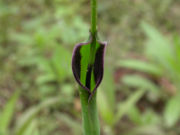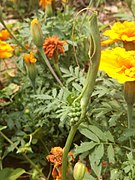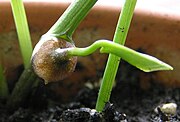Pinellia ternata
| Crow-dipper | |
|---|---|

| |
| Scientific classification | |
| Kingdom: | Plantae |
| Clade: | Tracheophytes |
| Clade: | Angiosperms |
| Clade: | Monocots |
| Order: | Alismatales |
| Family: | Araceae |
| Genus: | Pinellia |
| Species: | P. ternata
|
| Binomial name | |
| Pinellia ternata | |
Pinellia ternata (Chinese: 半夏, Japanese: カラスビシャク), crow-dipper, is a plant that is native to China, Japan, and Korea. However, it also grows as an invasive weed in parts of Europe (Austria, Germany) and in North America (California, Ontario, the northeastern United States).[1][2] The leaves are trifoliate, and the flowers are of the spathe and spadix form that is typical of plants in the family Araceae.[3]
Characteristics
[edit]The plant spreads by rhizomes, and there are also small bulblets (also known as bulbils) at the base of each leaf. Flowers are borne in spring.[4]
Traditional medicine
[edit]This plant is toxic in raw form and must be processed.[5] Pinellia ternata is known as the herb effective in removing phlegm-dampness in traditional Chinese medicine.[6][7] One study found that high doses of Pinellia extract effects thermogenesis and fatty acid oxidation in Zucker rats.[4]
Phytochemicals
[edit]Pinellia ternata contains a very wide variety of phytochemicals. The alkaloids found in its rhizomes include free nucleosides (guanosine, thymidine, adenine), N-benzylisomethylamine, cycloproline, cyclo(proline-leucine), cyclo(proline-valine), choline, L-ephedrine, inosine, trigonelline, and cytidine.[8]
Ephedrine content
[edit]- A 1996 Chinese article reports that processing method affects ephedrine levels; its native-language abstract reports a ephedrine content of 0.00344% (= 34.4 μg/g).[9]
- One 2020 Chinese study extracted 5.50 μg/g of ephedrine from tubers through multiphase extraction.[10]
- One 2021 Japanese study reports no ephedrine found in all 55 samples used (LC-TOF/MS, detection limit 0.5 ppb).[11]
Gallery
[edit]-
Plant as used in Chinese herbology (crude medicine)
-
The flower of Pinellia ternata, the Inflorescence
-
Mature Pinellia ternata
-
Pinellia ternata bulbil
References
[edit]- ^ Kew World Checklist of Selected Plant Families
- ^ Biota of North America Program, 2013 county distribution map
- ^ Flora of China Vol. 23 Page 42, 半夏 ban xia, Pinellia ternata (Thunberg) Tenore ex Breitenbach, Bot. Zeitung. 37: 687. 1879.
- ^ a b Kim, YJ; Shin, YO; Ha, YW; Lee, S; Oh, JK; Kim, YS (2006). "Anti-obesity effect of Pinellia ternata extract in Zucker rats". Biological & Pharmaceutical Bulletin. 29 (6): 1278–81. doi:10.1248/bpb.29.1278. PMID 16755034.
- ^ (Bensky et al.)2015.
- ^ Bensky, et all. 2015.
- ^ "Pinellia (Ban Xia) {!} Chinese Herbs Healing". Retrieved 2020-06-21.
- ^ ZHOU Yali; YANG Ping; LI Xixiang; LI Xiaofeng (19 July 2024). "半夏化学成分与药理作用研究进展及其质量标志物(Q-Marker)预测". 中草药 (in Chinese). 55 (14): 4939–4952. doi:10.7501/j.issn.0253-2670.2024.14.029. ISSN 1674-6376.
- ^ Wu, H; Tan, X; Cai, B; Ye, D (March 1996). 半夏姜制对麻黄碱含量的影响 认领 [Effect of ginger-processing on l-ephedrine contents in rhizoma Pinelliae]. Zhongguo Zhong yao za zhi = Zhongguo zhongyao zazhi = China journal of Chinese materia medica. 21 (3): 157–8, 190. PMID 9206255.
- ^ Fang, L; Xie, J; Lin, L; Tian, M; Row, KH (March 2020). "Multi-phase extraction of ephedrine from Pinellia ternata and herbal medicine using molecular imprinted polymer coated ionic liquid-based silica". Phytochemical analysis : PCA. 31 (2): 242–251. doi:10.1002/pca.2888. PMID 31435982.
- ^ Yahagi, T; Atsumi, T; Mano, S; Kikuchi, Y; Hara, Y; Furukawa, M; Yang, Z; Matsuzaki, K (June 2021). "Quality evaluation of Pinellia tuber by LC-TOF/MS targeted to ephedrine". Journal of natural medicines. 75 (3): 692–698. doi:10.1007/s11418-021-01485-2. PMID 33517509.




